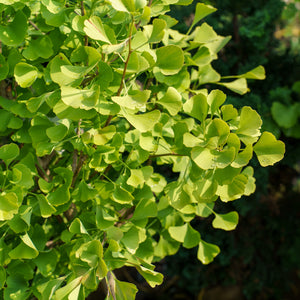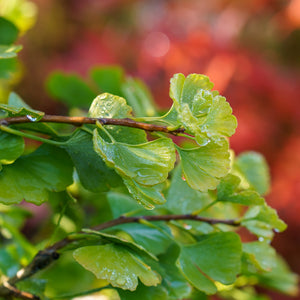The Ginkgo Guide
Ginkgo trees (Ginkgo biloba) are living fossils—unique, fan-leafed deciduous trees with origins dating back more than 200 million years. Revered for their golden fall foliage, pest resistance, and resilience in urban settings, ginkgos are prized for both their beauty and durability. Their distinctive, fan-shaped leaves and upright growth habit make them easily recognizable, and their ability to thrive in a wide range of conditions has earned them a place in parks, streetscapes, and gardens around the world.
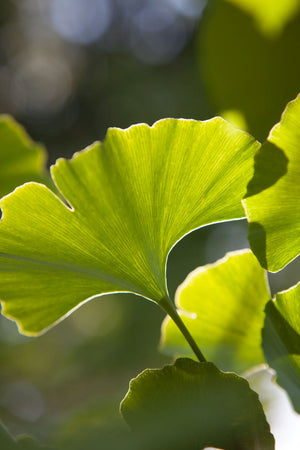
About
Ginkgo biloba is the only surviving member of an ancient plant division, making it one of the oldest tree species on Earth. Native to China and long cultivated in Asia for medicinal and cultural purposes, the ginkgo is now naturalized in temperate climates across the globe. Its strong resistance to pollution, pests, disease, and compacted soils makes it one of the most reliable trees for urban planting.
Modern cultivars have expanded the aesthetic and functional possibilities of the species. ‘Autumn Gold’ is a popular male clone known for its symmetrical shape and uniform golden fall color. Narrow selections like ‘Goldspire’, ‘Magyar’, and ‘Fastigiata’ are ideal for tight spaces or street-side plantings. Compact and dwarf forms such as ‘Mariken’, ‘Tschi Tschi’, and ‘Jade Butterfly’ are perfect for small gardens, patios, and container plantings. Unique varieties like ‘Weeping Wonder’ offer pendulous branching for a dramatic ornamental effect.
Ginkgo trees are dioecious, meaning male and female flowers occur on separate trees. Female trees produce seeds that contain butyric acid, which creates an unpleasant odor when the fruit drops and decays. As a result, most landscape selections are male clones, bred specifically to avoid the issue.
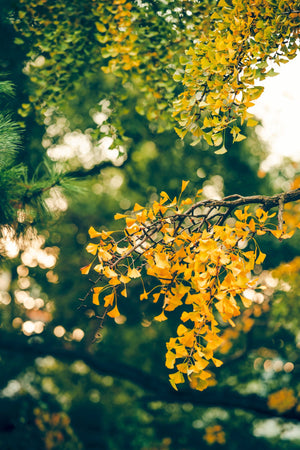
PLANTING
Planting ginkgo trees properly ensures a healthy, long-lasting specimen that will continue to thrive for generations.
USDA Hardiness Zones: Ginkgo trees grow well in Zones 4–9, making them adaptable across most of the United States.
Soil: Tolerant of a wide range of soils, including clay, loam, and sandy soils. Prefers well-drained sites but can tolerate short periods of drought or wetness once established.
Sunlight: Full sun is ideal for optimal growth and strong fall coloration. Ginkgo trees will tolerate partial shade, though growth may slow slightly.
Watering: Water young trees regularly during the first two growing seasons. Once established, ginkgos are drought-tolerant and require minimal supplemental water.
Spacing: Large upright cultivars like ‘Autumn Gold’ and ‘Fairmount’ should be spaced 25–35 feet apart. Narrow types like ‘Fastigiata’ and ‘Magyar’ can be spaced 15–20 feet apart. Dwarf forms such as ‘Mariken’ or ‘Troll’ can be planted 5–8 feet apart or used as single specimens in tight spaces.
Planting Time: Early spring or fall is best for planting. Avoid planting in midsummer heat unless irrigation can be maintained.
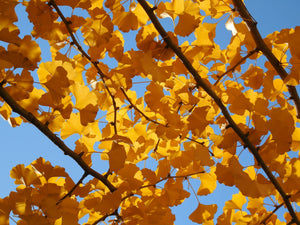
CARE
Ginkgo is a low-maintenance tree that thrives with minimal intervention once established.
Watering: Water deeply but infrequently, especially during dry periods. Overwatering or prolonged saturated soils should be avoided.
Fertilizing: Young trees benefit from a balanced, slow-release fertilizer in spring. Mature trees typically require no feeding unless growing in very poor soil.
Pruning: Minimal pruning is needed. Remove dead, damaged, or crossed branches in late winter to early spring. Avoid pruning the central leader on upright cultivars to preserve shape.
Pests & Diseases: Ginkgo has virtually no serious insect or disease problems. It is not susceptible to common tree issues such as anthracnose, cankers, or borers, making it an excellent long-term investment.
Mulching: Apply 2–3 inches of mulch around the base to regulate soil moisture and suppress weeds. Keep mulch away from the trunk to avoid rot.
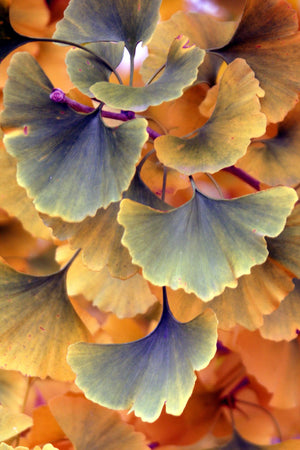
HOW TO USE
Ginkgo trees are one of the most versatile and timeless additions to landscape designs. Whether planted as towering focal points or used in tight garden spaces, their sculptural form, distinctive leaves, and unmatched resilience provide a wide range of design opportunities.
Focal Point: Tall, symmetrical selections like ‘Autumn Gold’ or ‘Spring Grove’ are ideal as focal points in front lawns, large borders, or public gardens. Their brilliant golden fall color draws the eye, while their upright, uniform habit brings structure and elegance to any setting.
Urban and Street Trees: Narrow cultivars such as ‘Magyar’, ‘Fastigiata’, and ‘Goldspire’ are outstanding for sidewalks, medians, and urban boulevards. Their tolerance of pollution, salt, and compacted soil makes them one of the most reliable trees in developed environments.
Small Gardens and Courtyards: Compact selections like ‘Tschi Tschi’, ‘Mariken’, and ‘Jade Butterfly’ are perfect for small-space gardening, patios, or even containers. These cultivars offer the same ornamental appeal in a much smaller footprint, ideal for townhomes, courtyard gardens, or Asian-inspired plantings.
Weeping or Architectural Specimens: Varieties like ‘Weeping Wonder’ provide a striking, architectural accent with cascading branches that work beautifully near water features, in meditation gardens, or as dramatic specimens in minimalist landscapes.
Companion Planting: Ginkgo’s upright growth and open canopy allow for understory planting. Combine with perennials such as Japanese forest grass (Hakonechloa), hostas, epimediums, or ferns to create a layered look beneath mature trees. For multi-season interest, pair with shrubs like hydrangea or viburnum to complement the ginkgo’s fall show.
Historical and Memorial Settings: Because of its longevity and symbolism of endurance, ginkgo is often used in memorial gardens, cemeteries, and institutional plantings.
Wildlife and Ecology: Ginkgo provides minimal direct value to wildlife but offers excellent canopy cover, windbreak capacity, and reliable shade. Its deep roots help reduce soil compaction and can contribute to long-term soil health.
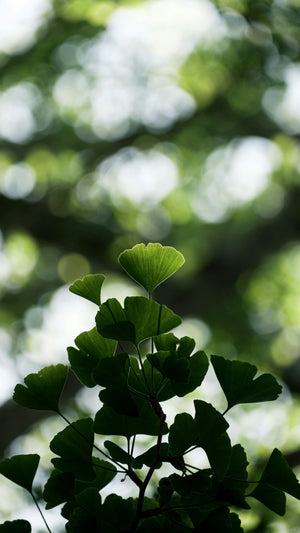
Common Questions
How fast do ginkgo trees grow? Ginkgo trees grow slowly when young—typically 6–12 inches per year for the first 5–10 years. Once established, growth may increase to 12–24 inches per year depending on cultivar and site conditions.
What is special about ginkgo trees? Ginkgos are among the oldest living tree species, with no close living relatives. Their distinctive fan-shaped leaves, extreme resilience, and brilliant fall color make them one of the most unique and ornamental trees in cultivation.
Do ginkgo trees stink? Only female ginkgo trees produce foul-smelling fruit when mature. Most landscape cultivars are male and do not produce fruit, avoiding this problem entirely.
How big does a ginkgo tree get? Mature ginkgo trees can reach 50–80 feet tall and 30–40 feet wide, depending on variety. Dwarf forms such as ‘Mariken’ and ‘Troll’ stay under 5 feet tall and wide.
How to plant a ginkgo tree? Choose a sunny location with well-drained soil. Dig a hole twice as wide as the root ball but no deeper. Place the tree so the root flare is level with the ground, backfill with native soil, water thoroughly, and mulch around the base.
Where do ginkgo trees grow? Ginkgo trees can grow in most temperate regions worldwide. In the U.S., they thrive across Zones 4–9 and are especially successful in urban and suburban environments due to their toughness.
How long do ginkgo trees live? Ginkgo trees can live for hundreds, even thousands, of years. Many specimens planted in the 1700s are still thriving today. With proper care, a landscape ginkgo can easily live for more than 100 years.
How tall do ginkgo trees grow? Depending on the cultivar, ginkgos range from compact dwarfs under 5 feet tall to full-sized trees reaching 80 feet or more in height.
Conclusion
Ginkgo trees combine ancient history with modern utility, offering unmatched durability, visual interest, and cultural significance. Their sculptural form, brilliant fall color, and tolerance to urban stress make them one of the most versatile and enduring trees available today. Whether used as a towering focal point, a narrow street tree, or a compact ornamental, ginkgos bring long-lasting value and beauty to the landscape.
The Ginkgo Collection
Sold Out

